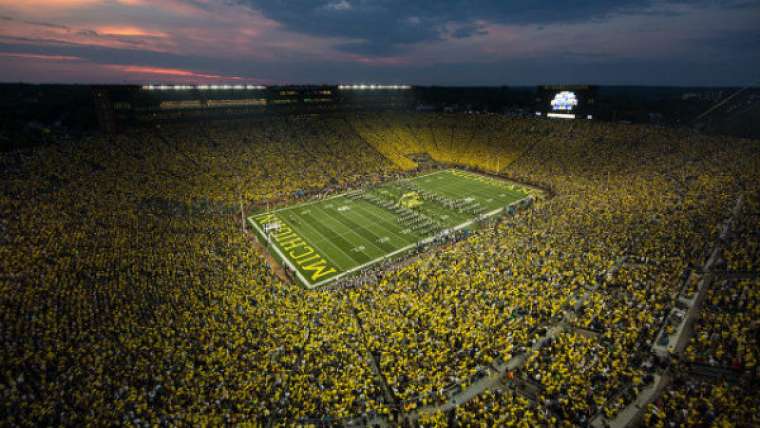Top 10 Largest Stadiums in the World by Seating Capacity
August 17, 2021 By Sourav

A stadium is where any sporting event is hosted, and people gather, with immense zest and zeal to be a part of a game, to watch their favorite men in action and take on the opponents and lift a trophy. At the largest stadiums, the excitement is palpable, and the people present at any stadium remind the players who they are playing for. At every stadium, some aspects are just common – thousands of fans in uniforms to show their devotion towards their favorites, flags on the faces, colorful faces and hairstyles, lots of sounds with people shouting, singing, and honking.
Largest Stadiums in the World by Capacity | 2021 Updates
They cheer to see every goal or shot, and they cry out when the opponents succeed. Without fans at the stadium, no match can be complete. The larger the crowd at the stadium, the greater is the excitement. Here is a list of the 10 Largest Stadiums in the World by Capacity. Let’s take a look.
10. Tiger Stadium
Outdoor sporting venue Tiger Stadium, famously known by locals as the Death Valley, is located in Baton Rouge, Louisiana. The stadium is the current home ground of the Louisiana State University Tigers football team and is also the sixth-largest stadium in the NCAA.
With its current Official Seating Capacity of 102,321 after several renovation projects, Tiger Stadium is now the ninth-largest active sports stadium in the world and is inducted in the tenth place in our list of 10 Largest Stadiums in the World by Capacity.
The construction of this stadium was started in 1924, and it was officially opened for the public on November 25, 1924, with a construction cost of nearly $1,816,210 at that time.
The stadium was originally designed by architects Wogan and Bernard and recently it was renovated under the guidance of Trahan Architects.
9. Neyland Stadium
Multi-purpose sports venue Neyland Stadium is located in Knoxville, Tennessee, and has been a site for several NFL exhibition games. The stadium is currently the home ground of the Tennessee Volunteers football team but it also hosted several large conventions.
With its official capacity of 102,455, Neyland Stadium is the fifth largest stadium in the United States. It is the eighth largest active stadium in the world and is inducted in the ninth place in our list of 10 Largest Stadiums in the World by Capacity.
Neyland Stadium got its name after UT football coach Robert Neyland. It went through 16 expansion projects till now. Authorities started the construction on 21st March 1921 with a budget of nearly $42,000 at that time.
They then officially opened it for the public on 24th September 1921. Architect McCarty Holsaple McCarty designed the recent conversion project of Neyland Stadium.
8. Ohio Stadium
American football venue The Ohio Stadium is located on the campus of The Ohio State University, United States, and was nicknamed “The Horseshoe” because of its shape.
The stadium serves as the home ground of the Ohio State Buckeyes football team and The Ohio State University Marching Band. With its seating capacity of 104,944, Ohio Stadium is the third-largest football stadium in the United States, the seventh-largest non-racing stadium in the world.
This stadium has earned the eighth place in our list of 10 Largest Stadiums in the World by Capacity. The authorities started the construction project on 3rd August 1921 with a construction cost of nearly $1.34 million.
They then opened it for the public on 7th October 1922. Architect Howard Dwight Smith designed this stadium and E. H. Latham Company worked as the general contractor.
7. Estadio Azteca
Famous soccer stadium The Estadio Azteca is located in the suburb of Santa Ursula in Mexico City and is the official national stadium of the Mexico national football team. Club América currently uses this stadium as its home venue.
It holds its place as the fourth-largest stadium in the American continent. Besides, it also deserves its place in the list of Largest Stadiums in the World by Capacity. This stadium currently has a seating capacity of 105,064.
The stadium features 856 Executive suites besides its normal seating arrangement. Authorities started the project in 1961 with a construction cost of nearly $260 million Mexican dollars.
They officially opened it for the public on 29th May 1966. Architect Pedro Ramírez Vázquez and Rafael Mijares Alcérreca designed this famous stadium.
6. Kyle Field
Collegiate football venue The Kyle Field is located on the campus of Texas A&M University in Texas and is the home of the Texas A&M Aggie football team since 1904. The stadium was nicknamed “Home of the 12th Man” and is the third-largest stadium in the United States.
With its gigantic seating capacity of 106,511, Kyle Field holds the fifth place among the largest active non-racing stadium in the world. Besides, it also deserves the sixth place in our list of 10 Largest Stadiums in the World by Capacity.
The stadium witnessed its record audience of 110,633 in a game between Texas A&M and Ole Miss Rebels on October 11, 2014. The authorities started the construction in May 1927.
And then, they officially opened it for the public on 24th September 1927. Architect F. E. Giesecke designed this venue. And, J. E. Johnson Construction Co. worked as the general contractor of the stadium.
5. Beaver Stadium
Penn State Nittany Lions of the Big Ten Conference uses the Beaver Stadium as their home venue. Located in University Park, Pennsylvania, this stadium got its name after the former governor A. Beaver.
With its official seating capacity of 106,572, Beaver Stadium became famous as the second-largest stadium in the Western Hemisphere. It also holds the fifth place in our list of 10 Largest Stadiums in the World by Capacity.
This stadium created a buzz after becoming the first sporting venue to have its interior included in Google Street View. Architect Michael Baker designed this stadium as the main architect.
Besides, Pennsylvania State University currently operates it. The authorities started the project in 1959 with a construction budget of nearly $1.6 million at that time. They then officially opened it for the public on 17th September 1960.
4. Michigan Stadium
University of Michigan’s football stadium The Michigan Stadium, nicknamed “The Big House”, is located in Ann Arbor, Michigan, and is the largest stadium in the United States. The stadium, with its current official capacity of 109,901, holds the 36th spot among the largest sports venue in the world.
Besides, it also holds the fourth place in our list of 10 Largest Stadiums in the World by Capacity. The University of Michigan currently owns and operates this stadium.
The authorities started the construction of this stadium on 12th September with a budget of nearly $950,000 at that time.
They then officially opened it for the public on 1st October 1927. Bernard L. Green designed this stadium as the main architect. Besides, James Leck Company worked as a general contractor.
3. Salt Lake Stadium
Fans know the multipurpose sporting venue Salt Lake Stadium as Yuva Bharati Krirangan. Located in the Indian city of Kolkata, it currently has a seating capacity of around 120,000.
It now hosts different kinds of cultural programs including dance and music concerts. This sports venue definitely deserves its place among the Largest Stadiums in the World by Capacity.
Authorities recently downsized this stadium from 120,000 to 68,000 in 2015. They did that by providing better seating arrangements during famous sporting events.
This stadium witnessed its record audience of 131,000 in a match between SC East Bengal and ATK Mohun Bagan in 1997. Authorities officially opened the Salt Lake Stadium for the public in January 1984. Indian Football Association currently operates this venue.
2. Rungrado 1st of May Stadium
Multi-purpose event venue The Rungrado 1st of May Stadium is located in Pyongyang, North Korea. It now mainly hosts Arirang performances, widely noted as the Mass Games.
This stadium has a capacity of around 150,000. It holds its place as the largest in Asia and the second largest in the world. This stadium also holds the second place in our list of 10 Largest Stadiums in the World by Capacity.
Rungrado 1st of May Stadium had its name after the Rungrado Islet in the Taedong River. It also got its name after the international Labor Day “May Day”.
The stadium features 16 arches arranged in a ring on its roof which resembles a magnolia blossom. The North Korean government opened this stadium for the public on 1st May 1989, with the main pitch covering nearly 22,500 square meters. DPR Korean government currently owned and controlled the Rungrado 1st of May Stadium.
1. Strahov Stadium
The Strahov district of Prague has the Great Strahov Stadium as its main multipurpose sports venue. Sparta Prague uses this ground as their main training ground.
It has a huge capacity of around 250,000 that made it the largest stadium in the world. Besides, it definitely deserves the top place in our list of 10 Largest Stadiums in the World by Capacity. Strahov Stadium is no longer used as an active sports venue. But, all of its 8 football pitches are now used solely for training purposes.
Architect Alois Dryák first designed this as a wooden stadium in 1926. Authorities later altered it with concrete grandstands in 1932. They then renovated this stadium in 1948 and 1975.
This stadium now covers nearly 63,500 square meters. Strahov Stadium hosted Motor racing during the mid-1960s. But, the stadium has never hosted any concerts since 1990.
Final Words
For sports fans, it is a dream to be present at the stadium to watch a game. This not only gives them a chance to see the performances of their favorite players from their favorite team up close but also enjoy the tremendous thrill in the environment. The true experience of watching a game remains incomplete until it is witnessed from the stadium.
Largest Stadiums In The World | Infographics


















Leave a Reply